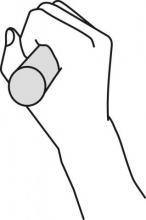
Grip is defined as the act of grasping and holding fast.1 Boys and girls have approximately the same grip strength until the age of 10 years, when boys’ grip strength becomes increasingly stronger than girls. Left-handed children tend to have equal strength in both hands, while right-handed children are significantly stronger in their dominant hand.2
Children need to have good grip strength to be able to use playground equipment. Holding on to spinning merry-go-rounds, climbing ladders on the slide, and sitting on swings all require a good grip. Brachiating on overhead ladders and rings especially require grip strength as well as upper body strength.
Most children, if they are not overweight, develop sufficient upper body strength and grip to support their body weight by the age of three and some children as early as two.3 Brachial behaviors of children on overhead equipment have been studied to observe the grip preference and movement pattern as they move across a ladder. Young children tend to prefer having the thumb over the bar, but as they mature the preference for the thumb under the bar begins to dominate.4
There are four basic grips. The lock grip is the position with the thumb under the bar and the fingers over it. The cup grip position has the thumb and fingers over the bar. If the thumb is extended at a 90 degree angle from the fingers with the fingers wrapped over the bar, it is the half-grip position. Finally, the oppositional grip has the hands facing each other either on the same bar or different bars.5
The diameter of the bars on overhead ladders may also influence the type of grip children use. Bars with smaller diameters may allow children to use the lock grip at younger ages. Ideally, overhead bars should be between 1 inch and 1-1/8 inch in diameter. Smaller bars tend to cause more blistering on hands.6
A strong grip is necessary for any climbing activity, whether climbing monkey bars, rock walls, ropes, or trees. Climbing equipment on the playground is the most common type of equipment, including overhead ladders, chinning bars, parallel bars, monkey bars, rock walls, and cargo net walls.7
- 1. “Grip.” Dictionary.com < www.dictionary.com > 30 July 2010.
- 2. Hager-Ross, C. and B. Rosblad. “Norms for grip strength in children aged 4-16 years.” PubMed.gov. < http://www.ncbi.nlm.nih.gov/pubmed/12162590 > 30 July 2010.
- 3. Frost, Joe L., Pei-San Brown, John A. Sutterby, Candra D. Thornton. The Developmental Benefits of Playgrounds. Olney, MD: Association for Childhood Education International, 2004. p. 93.
- 4. Ibid., p. 94.
- 5. Ibid., p. 102.
- 6. Ibid., p. 95.
- 7. Ibid., p. 135.

